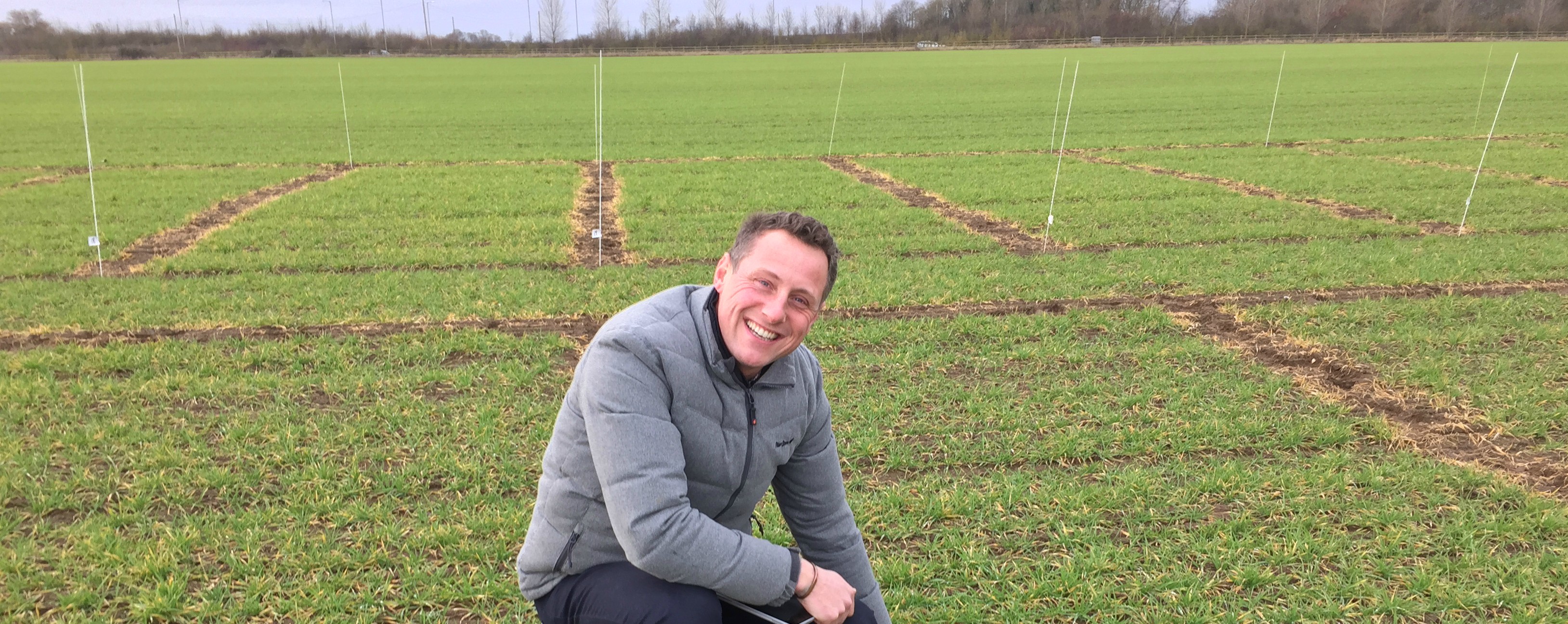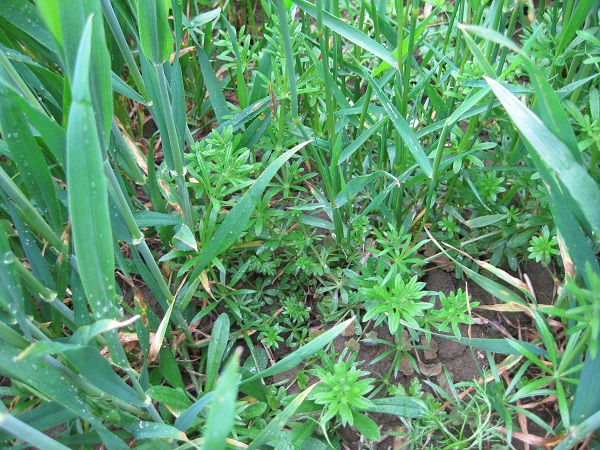
Waiting for warmer weather for broadleaf weed control may be jeopardising yield potential in some crops. CPM investigates the reasoning behind this claim.
Compelling evidence suggests a significant yield benefit from treating weeds earlier in the season
By Lucy de la Pasture
Clean crops and the potential for big yields are aspirations most growers share as a busy few months of fieldwork gets underway. When it comes to treating broadleaf weed problems, timing has been the name of the game for a number of years.
Dodging showers, ensuring temperatures allow active growth, and the ability to do two jobs in a single pass are all major drivers for the decision makers when planning herbicide applications.
While these are – and always have been – valid considerations, Dr Alex Nichols, cereals herbicide product manager for DowDuPont, has questioned whether it’s time to challenge the status quo.

The newer herbicide chemistry containing Arylex doesn’t need the warm conditions needed for other spring herbicides to work, enabling early removal of problem weeds like poppies.
Against a backdrop of new chemistry and fresh research, he’s advocating earlier applications of spring herbicides which, he says, could result in a significant payback come harvest time.
“Herbicide timings are tried and tested and, unless growers have had their fingers burnt they’ll stick to their methods and may not consider alternative strategies. But we’ve found some pretty compelling evidence from our research station that suggests a significant yield benefit can be derived from treating weeds earlier in the season,” he comments.
Winter cereals growers usually opt for a T1 or T2 tank mix for their main spring clean of cleavers, poppy, cranesbill and the other usual suspects. An application with the first dose of fungicides is also the most common approach for spring-sown crops, in order to hit the mid-to-late tillering timing.
Alex says this approach has been standard practice for some years. “The pattern is fairly static as growers look to gain efficiencies by going in at T1 with tank-mixed fungicides, PGRs and trace elements.”
The limitations associated with traditional chemistry are a contributing factor, he adds. “If you’re going to spend on weed control then you want to make sure it works, and farmers and agronomists have become accustomed to many herbicides performing best in warm, growthy conditions,” he notes.
Advocating change, Alex suggests the newer chemistry launched to the UK market in the past two years, opens the door to new approaches to herbicide applications.

Cleavers are one of the most competitive weeds and early removal will help protect yield potential according to trials.
He says Arylex -based herbicides defy performance preconceptions and, if applied early in the season, can deliver significant yield benefits. Trials at the company’s Wellesbourne site last year showed a 1.75t/ha yield benefit in winter wheat by treating crops in Feb rather than April.
Chickweed, poppy, cranesbill and cleavers were present in both trials and were totally controlled by Zypar (halauxifen-methyl+ florasulam) at 0.75 l/ha. But the trial treated on 24 Feb yielded 9.33t/ha, while the plot left until 24 Apr only yielded 7.58t/ha.
“Studies throughout the world have demonstrated that removing weed competition in cereals early results in more productive tillers, more grains per ear and a higher thousand grain weight,” he says.
“But the opportunities to take out key problem weeds early are not always there, or when they have presented themselves, growers have decided not to act.”
The arrival of Arylex, which was first seen in Pixxaro (halauxifen-methyl+ fluroxypyr) in 2016 before being launched in Zypar last spring, is part of the reason why Alex believes growers can now genuinely challenge the status quo.
“Arylex-based products have proven their efficacy in cold and variable weather conditions, so growers can carry out fieldwork targeting broadleaf weeds earlier in the season,” he says.
“It’s undisputed that applying herbicides when weeds are smaller results in a better kill. And when considering resistance, you’re more likely to achieve 100% kill when targeting small weeds, meaning the likelihood of a problem evolving is much reduced.”
Early treatment takes care of Northants weeds
Treating fields early to scupper the chances of competitive broadleaf weeds from eroding yield is a straight-forward concept when taken at face value. Factor in the vagaries of British springtime weather and the picture becomes somewhat cloudier.
Agrovista agronomist Rob Sheets says the strategy won’t be possible on every farm in every year, but where sprayers can travel and a weed problem exists, spraying early is a ‘no brainer’.
To illustrate his point, he uses a problem he found last spring in 14ha of winter barley in Northants as an example. “No pre-em was applied to the crop, so during the first week of March it was like a carpet of weeds and you couldn’t see the soil in parts,” he explains.
Cleavers, poppy, shepherd’s purse, cranesbill and other weeds such as fumitory posed the main challenges. Using an SU at full-rate – such as Finish SX (metsulfuron-methyl+ thifensulfuron-methyl) – followed by a mix of Starane (fluroxypyr) plus CMPP would have been the tried and tested route to tackle the problem.
That would have required a pass at the T0 and T1 fungicide timings and would have ramped up the pressure on the SUs as well as further complicating the fungicide tank mix.
“Having looked at Whorl (halauxifen-methyl+ fluroxypyr) and the spectrum of weeds it controls, it matched up well so we decided to go with that in the tank at 0.375 l/ha with an SU at a lower rate. Within a day or two, it was already showing activity. That would have been the Arylex kicking in because the SU takes longer. Four weeks later everything was dead.”
The farm is likely to get a similar treatment this year as no pre-em was applied in the autumn to its wheat crop. “A lot of the farms I deal with are stacking pre-em chemistry in the autumn, so they haven’t got a huge broadleaf weed spectrums come March.
“Those who don’t get a pre-em on because the weather closes in, or there isn’t a grassweed problem to contend with, have significant challenges in the spring. Travelling is often the limiting factor when it comes to early application, and that will come down to the soil type and conditions,” he says.
Late-emerging weeds will also be a concern for growers who don’t want to spend early, only to get problems in April and May, he points out. “It’s a case of knowing your weeds and knowing your fields. If you’re doing weed control early and you have a competitive crop, then it should be able to pull away from any late-emerging weeds.”
Close attention needed to control problem weed
The constant monitoring of the umbelliferous weed burr chervil has become a necessary practice for a Wilts arable farmer, who’s seen a significant increase in this aggressive weed over the past few years.
David White says constant monitoring of the weed across his 1200ha has become a necessary part of his agronomy practice in order to keep it in check. Working closely with independent AICC agronomist, Steve Cook of Hampshire Arable Systems, David and his son Edward have mapped their whole farm, identifying problem areas and religiously walking every acre.
He firmly believes that although they’re able to achieve excellent control by using a pre-T0 application of full-rate Ally Max (metsulfuron-methyl+ tribenuron-methyl), the weed is still spreading and any additional opportunities to limit that spread must be addressed.
“Last year we achieved 100% control by making the application in good conditions on 15 March,” he explains. “We could see that the weed was starting to move and if you leave it any longer, you’re already on the back foot. Timing is everything.”
Later applications not only lead to poorer control with foliar suppression at best, but very often yield has already been lost through increased competition for nutrients and light.
“We noticed in on-farm trials, applications made later (up till the end of April) just didn’t have the same efficacy. The burr chervil was only stunted and to do a complete job, we realised we had to be on the ball as soon as conditions allowed us to travel.”
The cereal crops on the farm offer the only chance of successful control, which is a big problem in OSR. Although David employs a robust pre and early post-em programme in the autumn on both wheat and barley, the effect of autumn residual herbicides on the burr chervil is minimal.
“We’ve stopped using Atlantis (mesosulfuron-methyl+ iodosulfuron-methyl-sodium) in the autumn now and only sparingly thereafter,” he says. “We find that it’s far better to wait until early spring or even late winter to use the first SU, especially where the burr chervil is concerned. We know it’s going to be an expensive practice, but frankly, anything less is a false economy.”
Cold weather aiding blackgrass control
Cold and wet weather has been the main feature of 2018 so far, and even though it’s limiting opportunities for fieldwork, it’s helping keep blackgrass under control too.
“Quite clearly it’s been wet and cold so there hasn’t been much opportunity to do fieldwork. Soil temperatures are still low and there have been very few dry days to do any spraying in wheat crops,” says Jack Hill of Bayer who works with farmers in Norfolk. According to Jack, cold weather and a good pre-emergence programme last autumn are doing a good job controlling blackgrass.
“Residuals have kept chipping away through the winter and have been helped by cold, frosty conditions. Where farmers topped up the residual in autumn, the control is very good but where there was no top-up, we’re seeing some surviving blackgrass at the 1–2 leaf stage.”
Where there are survivors, the next decision is whether to apply a post-emergence herbicide. With blackgrass still being fairly small, there’s a good opportunity to control it with Monolith (mesosulfuron+ propoxycarbazone), even in situations with some metabolic resistance, he says.
“As soon as land is fit to travel consider spraying,” says Jack. “Some people might worry about low soil temperature, but we’re unlikely to see double figures for a couple of months. For an early spring post-em application, the main focus is on waiting for a dry, bright day so the herbicide can land and settle on the blackgrass leaf.”
Jack reminds growers that on land which didn’t receive a top-up residual in autumn, there’s the option to use 0.3 l/ha of Liberator (flufenacet+ diflufenican) until 31 March if further germination of grassweeds is expected.
Further north in Lincs, Jack’s colleague Darren Adkins reports a similar situation in the field and reminds growers that with limited spray windows, it’s important to target specific fields. “On the whole pre-em herbicides and stacks went on in good conditions and have performed reasonably well. But you need to assess weed populations carefully to identify which fields require a follow-up, so you can treat them as a priority as soon as conditions improve,” he says.




